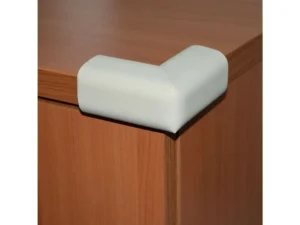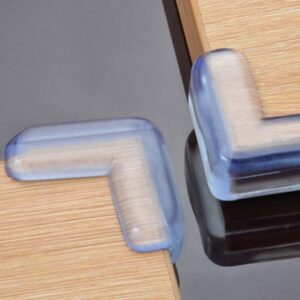Furniture corner protectors are essential tools for enhancing home safety, especially if you have children or pets. Whether you’re a parent looking to child-proof your home or someone aiming to prevent furniture damage, corner protectors are a simple yet effective solution. This guide explores everything you need about furniture corner protectors, including their benefits, types, installation tips, and buying advice.
1. What Are Furniture Corner Protectors?
Furniture corner protectors are safety devices designed to cover the sharp or pointed edges of tables, chairs, cabinets, and other furniture pieces. They are typically made from foam, silicone, plastic, or metal materials. These protectors serve two primary purposes: to prevent injuries caused by sharp corners and to protect furniture from damage. They are easy to install, affordable, and available in various shapes and colors to suit different furniture styles.
2. Why Do You Need Furniture Corner Protectors?
Furniture corner protectors are more than just safety accessories. Here are some compelling reasons why you need them:
- Child Safety: Kids are prone to accidents, and sharp furniture edges pose a significant risk. Corner protectors reduce the chances of head injuries, bruises, and cuts.
- Pet Safety: If you have active pets, corner protectors can prevent them from getting hurt while playing around furniture.
- Prevent Furniture Damage: Corner protectors can minimize wear and tear, keeping your furniture edges intact and free from chips or scratches.
- Office Safety: Corner guards in workspaces can help maintain a safer environment and reduce potential liability from accidents.
3. Types of Furniture Corner Protectors
Corner protectors come in various types, each designed for specific needs. Here are the most common ones:
3.1. Soft Foam Corner Protectors
- Material: Soft, high-density foam
- Best For: Homes with babies or toddlers
- Features: Thick padding, absorbs impact, easy to install
- Pros: Affordable, available in multiple colors
- Cons: May wear out over time
3.2. Silicone Corner Protectors
- Material: Flexible silicone
- Best For: Aesthetic-conscious homes
- Features: Transparent, durable, shock-absorbent
- Pros: Blends with furniture, long-lasting
- Cons: Slightly more expensive than foam
3.3. Plastic Corner Guards
- Material: Hard plastic
- Best For: High-traffic areas, offices
- Features: Rigid protection, available in various colors
- Pros: Durable, resists wear and tear
- Cons: Not as soft as foam or silicone
3.4. Metal Corner Protectors
- Material: Stainless steel or aluminum
- Best For: Protecting furniture from damage
- Features: Sleek design, heavy-duty protection
- Pros: Ideal for industrial or vintage furniture
- Cons: Not suitable for child safety
3.5. Adhesive vs. Non-Adhesive Options
- Adhesive: Stick securely to furniture; easy to install but may leave residue.
- Non-Adhesive: Slide onto furniture corners; reusable and leave no residue.

4. How to Choose the Best Furniture Corner Protectors
Choosing the right corner protectors depends on several factors:
- Purpose: Child safety, pet safety, or furniture preservation
- Material: Foam, silicone, plastic, or metal based on your needs
- Aesthetic: Transparent or color-matched to fit your furniture style
- Durability: High-traffic areas need more durable options like plastic or metal
- Ease of Installation: Adhesive protectors for convenience; non-adhesive for flexibility
5. How to Install Furniture Corner Protectors
Installing furniture corner protectors is simple and quick. Here’s a step-by-step guide:
- Clean the Surface: Wipe the corner with a damp cloth to remove dust and oil.
- Measure and Fit: Check the protector’s size and fit it to the furniture corner.
- Peel Adhesive Backing: If adhesive, remove the backing to expose the sticky surface.
- Apply Firmly: Press the protector onto the corner and hold for 30 seconds.
- Check for Stability: Ensure it’s securely attached before use.
For non-adhesive protectors, simply slide the protector onto the corner and adjust as needed.
6. Top 5 Furniture Corner Protectors on the Market
Finding the right corner protectors can be overwhelming with so many options available. Here are the top 5 highly recommended corner protectors that cater to different needs:
1. Roving Cove Baby-Proofing Corner Guards
- Material: High-density foam
- Best For: Child safety
- Features: BPA-free, fire-resistant, and thick cushioning
- Pros: Easy to install and available in multiple colors
- Cons: Adhesive may leave residue if removed forcefully
2. CalMyotis Clear Silicone Corner Protectors
- Material: Transparent silicone
- Best For Homes where aesthetics matter
- Features: Soft, flexible, and blends seamlessly with furniture
- Pros: Durable and visually unobtrusive
- Cons: Slightly pricier than foam options
3. Sure Basics Soft Corner Guards
- Material: Soft foam
- Best For: Budget-friendly baby-proofing
- Features: Easy peel-and-stick application
- Pros: Affordable and effective
- Cons: May wear out quickly with heavy use
4. Bebe Earth Edge and Corner Protector Set
- Material: Foam with reinforced edges
- Best For: Comprehensive safety needs
- Features: Includes both edge and corner protectors
- Pros: Complete safety solution for larger furniture pieces
- Cons: Bulkier appearance
5. Uxcell Metal Corner Guards
- Material: Stainless steel
- Best For: Industrial and vintage-style furniture
- Features: Heavy-duty protection against damage
- Pros: Durable and stylish for non-childproof settings
- Cons: Not suitable for child safety purposes
7. Safety Tips for Using Furniture Corner Protectors
To maximize the safety and effectiveness of your corner protectors, follow these essential tips:
- Check Regularly: Ensure the corner protectors are securely attached and not peeling off.
- Replace Worn-Out Protectors: Over time, foam and silicone protectors may wear out; replace them promptly.
- Clean Surfaces Before Installation: Dirt and dust can weaken adhesive strength.
- Supervise Kids and Pets: While corner protectors reduce injury risk, supervision is still necessary.
- Choose Non-Toxic Materials: Opt for BPA-free, phthalate-free options for child safety.
8. DIY Furniture Corner Protectors
If you’re in a pinch or enjoy DIY projects, you can create your corner protectors with household items. Here’s how:
Materials Needed
- Old foam or sponge
- Duct tape or masking tape
- Scissors
Steps to Make DIY Corner Protectors
- Cut the Foam: Slice the foam into small square pieces, large enough to cover the corners.
- Shape the Corners: Fold the foam around the sharp corner.
- Secure with Tape: Use duct tape to hold the foam in place. Wrap the tape securely around the corner for stability.
Pros of DIY Protectors:
- Cost-effective
- Immediate solution
Cons of DIY Protectors:
- Less durable
- May not look as neat or professional
9. Benefits of Using Furniture Corner Protectors
Using furniture corner protectors offers a wide range of benefits:
- Prevents Injuries: Reduces the risk of head injuries, cuts, and bruises, especially for children and pets.
- Protects Furniture: Prevents damage to furniture edges, preserving their appearance.
- Peace of Mind: Knowing your home is safer brings comfort and reassurance.
- Easy Installation: No special tools are required, making it a hassle-free solution.
- Affordable Safety: Corner protectors are a budget-friendly way to child-proof your home.
10. Common Myths About Corner Protectors
Let’s debunk some of the common misconceptions about corner protectors:
- Myth: They Damage Furniture
- Reality: Quality corner protectors are designed to be removed without damaging furniture surfaces.
- Myth: Only for Families with Kids
- Reality: Corner protectors also benefit pet owners, offices, and anyone looking to protect furniture.
- Myth: They’re Unattractive
- Reality: Modern silicone and clear protectors blend seamlessly with furniture designs.
- Myth: Installation Is Complicated
- Reality: Most protectors use simple peel-and-stick adhesive or slip-on mechanisms.
11. Where to Buy Corner Protectors
Corner protectors are widely available both online and in stores. Here are some popular purchasing options:
- Online Marketplaces:
- Amazon
- eBay
- Walmart
- Specialty Baby Stores:
- Buy Buy Baby
- Babylist
- Home Improvement Stores:
- Home Depot
- Lowe’s
- Office Supply Stores:
- Staples
- Office Depot
12. Maintenance and Care for Corner Protectors
To keep your corner protectors in top condition:
- Regular Cleaning: Wipe them down with a damp cloth to remove dust and grime.
- Check Adhesive: Ensure the adhesive remains strong; replace if peeling occurs.
- Avoid Harsh Chemicals: Use mild soap and water to prevent material damage.
- Replace When Needed: If protectors show signs of wear, replace them to maintain safety.

13. Furniture Corner Protectors for Different Settings
Different environments may require specific types of corner protectors:
- Home Use: Soft foam or silicone for child safety.
- Offices: Durable plastic corner guards for high-traffic areas.
- Schools and Daycares: Thick foam protectors for maximum safety.
- Restaurants: Clear silicone for aesthetics and safety.
14. Eco-Friendly Corner Protectors
Environmentally conscious consumers can opt for eco-friendly corner protectors. These are typically:
- Made from Recyclable Materials: Silicone and certain plastics are recyclable.
- Non-toxic: Free from harmful chemicals like BPA and phthalates.
- Biodegradable Options: Some foam protectors are designed to break down naturally.
15. Conclusion
Furniture corner protectors are simple, effective, and essential tools for ensuring safety at home and beyond. Whether you’re a parent looking to baby-proof your home, an office manager enhancing workplace safety, or someone aiming to protect valuable furniture, there are options to meet your needs. With various types, materials, and installation methods available, corner protectors are a small investment that provides peace of mind and protection.
FAQs
1. Are corner protectors easy to remove?
Yes, most furniture corner protectors are designed to be easily removed without damaging the furniture.
2. How do I clean silicone corner protectors?
Use a damp cloth with mild soap to wipe them clean.
3. Can I reuse corner protectors?
Some non-adhesive protectors can be reused, while adhesive types may lose stickiness after removal.
4. Are metal corner protectors safe for children?
No, metal corner protectors are better suited for furniture protection, not child safety.
5. Do corner protectors leave a residue?
High-quality adhesive corner protectors generally do not leave a residue if removed carefully.

